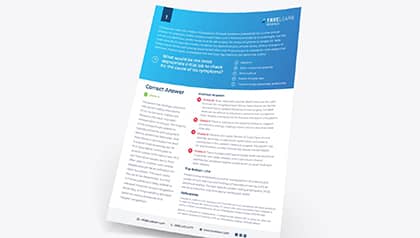Free PRITE Sample Practice Questions from Our 2025 Edition
See why TrueLearn is a trusted resource for thousands of medical students and residents. We understand that it’s all about the content. That’s why we have high-yield PRITE practice questions written and screened by high-performing physician authors that are updated on a regular basis to ensure our SmartBanks stay up-to-date with ABPN Certification and PRITE blueprint changes. See what we mean with the below free PRITE sample question from our 2025 Edition.
Your First Free PRITE Question
A 28-year-old woman with a history of restless legs syndrome presents with a 15-pound weight gain. She says she wakes up in the morning to discover she has eaten everything in her pantry. You decide to treat her with carbidopa/levodopa.
Which of the following is TRUE regarding the mechanism of action of this drug?
- A) Carbidopa inhibits decarboxylation of peripheral levodopa.
- B) Carbidopa inhibits hepatic biotransformation of levodopa.
- C) Carbidopa is a dopamine receptor agonist.
- D) Levodopa increases the half-life of carbidopa.
- E) Levodopa is a dopamine receptor antagonist.
Answer and Explanation
Levodopa is converted into the neurotransmitter dopamine. Levodopa is able to cross the blood-brain barrier and enters the dopaminergic neurons of the central nervous system (CNS). Carbidopa inhibits decarboxylation of peripheral levodopa. It does not cross the blood-brain barrier and does not affect the metabolism of levodopa within the central nervous system. Since its decarboxylase-inhibiting activity is limited to extracerebral tissues, administration of carbidopa with levodopa makes more levodopa available for transport to the brain. Carbidopa reduces the amount of levodopa required to produce a given response by about 75%.
This patient has sleep-related eating disorder, or per DSM-V nomenclature, non-rapid eye movement sleep arousal disorder with sleep-related eating. Sleep-related eating disorder is frequently comorbid with restless legs syndrome (RLS). One study found as many as 33% of people with RLS also have sleep-related eating disorder. Dysregulation in the dopamine system has been implicated in the compulsive nature of sleep-related eating disorder and abnormal limb movements in restless legs syndrome. These disorders often improve with dopaminergic drugs such as carbidopa/levodopa.
Did you get it right? The correct answer is A.
Incorrect Answer Explanations
- B) Carbidopa inhibits hepatic biotransformation of levodopa: Carbidopa inhibits decarboxylation of peripheral levodopa.
- C) Carbidopa is a dopamine receptor agonist: Carbidopa has no direct effect on dopamine.
- D) Levodopa increases the half-life of carbidopa: Carbidopa increases the half-life of levodopa.
- E) Levodopa is a dopamine receptor antagonist: Levodopa is converted to dopamine.
Bottom Line
Levodopa is converted into the neurotransmitter dopamine through decarboxylation. Carbidopa inhibits decarboxylation of peripheral levodopa, making the half-life of levodopa longer.
Get More Free PRITE Practice Questions
Ready for more practice questions? Sign up for a free trial of our Psychiatry In-Training SmartBank.


